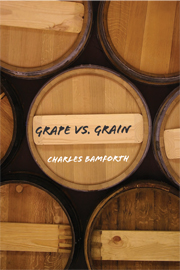Book contents
- Frontmatter
- Contents
- Preface
- Grape vs. Grain
- 1 Beer and Wine: Some Social Commentary
- 2 A Brief History of Wine
- 3 A Brief History of Beer
- 4 How Wine Is Made
- 5 How Beer Is Made
- 6 The Quality of Wine
- 7 The Quality of Beer
- 8 Types of Wine
- 9 Types of Beer
- 10 The Healthfulness of Wine and Beer
- 11 Conclusions about Beer and Wine – and the Future
- Further Reading
- Index
3 - A Brief History of Beer
Published online by Cambridge University Press: 16 September 2009
- Frontmatter
- Contents
- Preface
- Grape vs. Grain
- 1 Beer and Wine: Some Social Commentary
- 2 A Brief History of Wine
- 3 A Brief History of Beer
- 4 How Wine Is Made
- 5 How Beer Is Made
- 6 The Quality of Wine
- 7 The Quality of Beer
- 8 Types of Wine
- 9 Types of Beer
- 10 The Healthfulness of Wine and Beer
- 11 Conclusions about Beer and Wine – and the Future
- Further Reading
- Index
Summary
A high and mighty liquor, made of barley and water.
Julius CaesarThe history of beer is certainly no shorter or less illustrious than that of wine or, indeed, that of other beverages that evolved at a similar time by the “spontaneous” fermentation of a diversity of materials: from moistened grain (beer), through grapes (wine), to honey (mead), and milk (kvass).
In all instances, these products, with their hedonic attributes and the entry they allowed to an altered state of consciousness, had a profound social and economic impact. Furthermore, as we saw in Chapter 2, for wine and as is almost certainly more likely the case for beer, they featured as prime causative factors in the advent of static societies. They were a fundamental part of the diet and were undoubtedly recognized as being altogether healthier to drink than water alone. Alcohol is a great killer of pathogenic microbes but more than that, a professor of anthropology at Emory University, George Armelagos, found evidence for the bacterium Streptomycedes in relics from ancient Sudan and has suggested that beer at the times was likely a significant source of the “natural” antibiotic tetracycline. Beer is almost a wonder food: nutritionally enriched, hedonistically satisfying, and medically protective.
Climate, of course, played a substantial role in dictating the beverage of choice. In northern and western Europe, then, it was probably honey that constituted the first alcoholic beverage base, before the days of cultivation of the cereal grasses.
- Type
- Chapter
- Information
- Grape vs. GrainA Historical, Technological, and Social Comparison of Wine and Beer, pp. 23 - 60Publisher: Cambridge University PressPrint publication year: 2008



